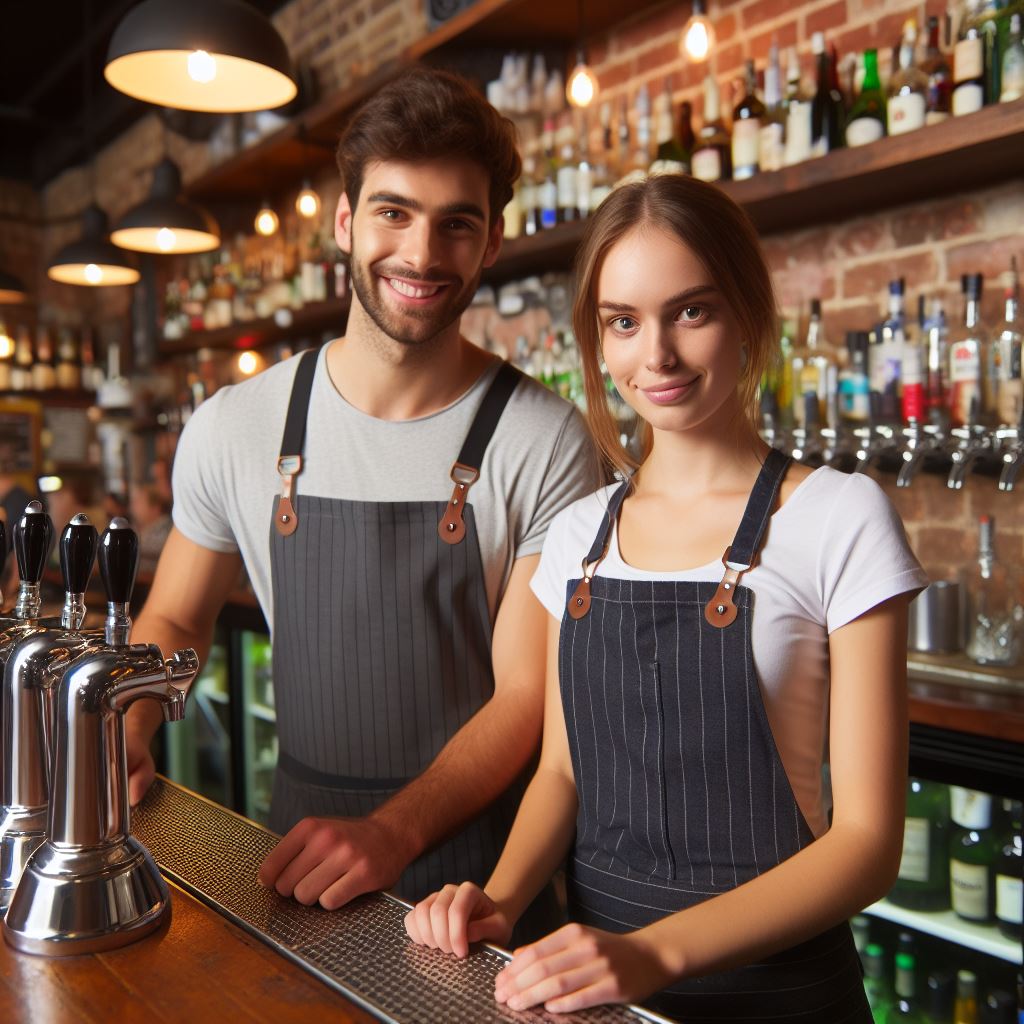Introduction to the Importance of Wine Knowledge for Bartenders in Australia
A. Wine’s Popularity Surge
- Australian wine consumption surges, reflecting global trends.
- Wine culture expands beyond traditional circles.
- Bartenders increasingly sought after for wine expertise.
B. Bartenders’ Vital Role
- Bartenders serve as frontline ambassadors for wine.
- They influence customer preferences and choices.
- Their knowledge enhances overall drinking experience.
C. Purpose of this Blog
- Provide insights into Australian wine trends.
- Equip bartenders with essential wine knowledge.
- Offer practical tips for improving wine expertise.
In Australia’s dynamic beverage scene, wine holds a significant place. Bartenders, as key influencers, wield substantial power in shaping wine culture.
This blog aims to empower bartenders with the knowledge and skills needed to navigate and excel in the ever-evolving world of wine.
The Basics of Wine
A. Red, white, and sparkling wines
- Red wines are made from dark-colored grapes and have a deeper color and richer flavor.
- White wines are made from light-colored grapes and have a lighter color and crisper taste.
- Sparkling wines have carbon dioxide bubbles, giving them a fizzy texture and are commonly associated with celebrations.
B. The differences in taste and characteristics of each type
- Red wines are known for their complex flavors, such as blackberry, cherry, and spices.
- White wines are more refreshing and often have notes of citrus, pear, and floral aromas.
- Sparkling wines have a lively effervescence that adds a playful element to their fruity and crisp taste.
C. The importance of understanding wine production and regions
- Understanding wine production helps bartenders in recommending and pairing wines with different dishes.
- Knowing wine regions enables bartenders to guide customers towards wines from specific regions known for their exceptional quality.
- Familiarity with production and regions helps bartenders establish credibility and enhance the overall dining experience for patrons.
D. Common wine terms
- Tannin: a substance found in grape skins and seeds that gives a dry or bitter taste to wines.
- Acidity: the level of tartness or sourness in a wine, balancing the sweetness and influencing its freshness.
- Aroma: the scent or smell of wine, often described using terms like fruity, floral, or spicy.
- Body: the weight and fullness of a wine in the mouth, ranging from light-bodied to full-bodied.
- Vintage: the year in which the grapes used in a wine were harvested.
- Terroir: the combination of soil, climate, and other environmental factors that influence the character of a wine.
- Oak-aged: wine that has been aged in oak barrels, imparting flavors and aromas like vanilla and toast.
- Dry: a wine that has little to no sweetness.
- Residual sugar: the amount of natural grape sugars remaining in a wine after fermentation, determining its sweetness.
- Bouquet: the complex set of aromas that develop in wines with age.
Having a solid understanding of these wine terms helps bartenders effectively communicate with customers and make informed suggestions based on their preferences.
By mastering the basics of wine, bartenders in Australia can elevate their expertise, provide excellent service, and enhance customer satisfaction.
Wine Service Essentials
A. Proper way to store and cellar wine
- Store wine horizontally to keep the cork moist and prevent it from drying out.
- Avoid exposing wine to direct sunlight or extreme temperatures to maintain its quality.
- Store wine in a cool, dark, and well-ventilated area with a consistent temperature.
- Consider investing in a wine cellar or wine fridge for optimal storage conditions.
B. Importance of correct serving temperatures for different wines
- Champagne and sparkling wines should be served chilled at around 7-9°C (45-48°F).
- White wines taste best when served chilled, typically between 8-12°C (46-54°F).
- Red wines should be served slightly below room temperature, around 15-18°C (59-64°F).
- Serving wine at the correct temperature enhances its aromas and flavors.
- Temperature can significantly impact the overall drinking experience of a wine.
C. Correct glassware for serving wine
- Choose clear, unadorned glasses to visually appreciate the wine’s color and clarity.
- For white wines, use smaller, narrower glasses to concentrate the delicate aromas.
- Red wines benefit from larger, wider glasses that allow the wine to breathe.
- Sparkling wines should be served in flutes to preserve the bubbles.
- Having a variety of glassware options can enhance the wine tasting experience.
D. Tips on opening and pouring wine
- Use a waiter’s corkscrew or sommelier knife to remove the cork with ease.
- Ensure the bottle is upright before opening to prevent spills and maintain control.
- Gently twist the corkscrew into the cork, then pull it out slowly and steadily.
- When pouring, hold the bottle by the base, tilt it slightly, and pour slowly to avoid spills.
- Avoid overfilling the glass to allow room for swirling and appreciating the wine’s aromas.
Proper wine service in Australia demands mastery of storage, temperature, glassware, and pouring techniques.
Storing wine horizontally prevents cork dryness. Maintaining consistent cool, dark conditions preserves wine quality.
Correct serving temperatures highlight wine flavors. Clear, unadorned glassware showcases wine’s characteristics.
Use smaller, narrower glasses for white wines. Opt for larger, wider glasses for red wines. Serve sparkling wines in flutes to preserve bubbles.
Open wine bottles with a corkscrew or sommelier knife. Keep the bottle upright to prevent spills. Twist and pull the cork gently for smooth extraction. Pour wine slowly to avoid splashing.
Hold the bottle by the base and tilt it slightly. Leave space in the glass for swirling. Mastery of wine service elevates customer experience.
Read: The Role of Tech in Modern Travel Agencies
Popular Wine Regions in Australia
A. Major wine regions in Australia
- Barossa Valley: Known for its Shiraz, Barossa Valley is one of Australia’s premier wine regions.
- Hunter Valley: Renowned for its Semillon and Shiraz, Hunter Valley is the oldest wine region in Australia.
- Yarra Valley: Famous for its Chardonnay and Pinot Noir, Yarra Valley is known for producing elegant cool-climate wines.
- McLaren Vale: Specializing in Shiraz and Grenache, McLaren Vale is known for its Mediterranean-style wines.
- Coonawarra: Noted for its Cabernet Sauvignon, Coonawarra’s unique soil and climate produce exceptional red wines.
- Margaret River: Known for its Cabernet Sauvignon and Chardonnay, Margaret River produces premium wines with a Bordeaux-style elegance.
B. Unique characteristics and popular varietals from each region
1. Unique characteristics
- Barossa Valley: With a Mediterranean climate, the region produces bold, full-bodied red wines, especially Shiraz.
- Hunter Valley: Its warm climate allows for the production of exceptional Semillon and medium-bodied Shiraz.
- Yarra Valley: Cool climate and fertile soil result in elegant Chardonnay, Pinot Noir with bright acidity and complexity.
- McLaren Vale: A warm and dry climate leads to ripe and juicy Shiraz and Grenache with rich flavors.
- Coonawarra: Its famous Terra Rossa soil gives rise to structured Cabernet Sauvignon with intense flavors and aging potential.
- Margaret River: Balanced maritime climate nurtures Cabernet Sauvignon with cassis flavors and Chardonnay with complexity and finesse.
2. Popular varietals
- Penfolds Grange (Barossa Valley): A legendary Shiraz that has consistently received high ratings and accolades.
- Tyrrell’s Vat 1 Semillon (Hunter Valley): An iconic Semillon with its distinctive citrus and toasty characters.
- Yarra Yering Dry Red No. 1 (Yarra Valley): A blend of Cabernet Sauvignon, Merlot, Malbec, and Petit Verdot, delivering complexity and elegance.
- d’Arenberg The Dead Arm Shiraz (McLaren Vale): A powerful and concentrated Shiraz with layers of dark fruit and spices.
- Wynns Coonawarra Estate John Riddoch Cabernet Sauvignon (Coonawarra): A benchmark Cabernet Sauvignon with exceptional structure and longevity.
- Vasse Felix Heytesbury Chardonnay (Margaret River): A refined Chardonnay with a harmonious combination of stone fruits and creamy texture.
C. Wines from specific regions that bartenders should be familiar with
- Penfolds Kalimna Bin 28 Shiraz (Barossa Valley): A versatile and approachable Shiraz to suggest to customers seeking full-bodied red wines.
- Brokenwood Cricket Pitch White (Hunter Valley): An easy-drinking white blend with tropical fruit aromas, perfect for a refreshing summer choice.
- De Bortoli Estate Grown Cabernet Sauvignon (Yarra Valley): A fine example of cool-climate Cabernet Sauvignon with elegance and vibrant acidity.
- Wirra Wirra Church Block (McLaren Vale): A crowd-pleasing blend of various red varieties, offering soft tannins and flavors of dark fruits.
- Wynns Coonawarra Estate Shiraz (Coonawarra): An elegant, medium-bodied Shiraz with a balanced structure and red berry aromas.
- Leeuwin Estate Art Series Chardonnay (Margaret River): An iconic Chardonnay expressing complexity, richness, and well-integrated oak.
Read: Navigating COVID-19: Travel Agents’ Advice

Explore Further: Famous Australian Bars and Their Signature Drinks
Learn More: Bartending in Australia: Salary Expectations
Wine and Food Pairing
A. The concept of pairing wine with food
Pairing wine with food is an art that enhances the dining experience. It involves matching complementary flavors and textures.
Your Personalized Career Strategy
Unlock your potential with tailored career consulting. Get clear, actionable steps designed for your success. Start now!
Get StartedB. Common guidelines for successful wine and food combinations
Consider the intensity of both the dish and the wine. Light dishes typically pair well with light-bodied wines, while heavier dishes benefit from full-bodied wines.
Try to balance flavors. For example, a sweet wine can complement a spicy dish, while an acidic wine can cut through rich, fatty flavors.
Think about the region of the wine and food. Pairing a local wine with a local dish can create a harmonious combination.
C. Examples of popular wine and food pairings in Australia
In Australia, some classic wine and food pairings include:
- Chardonnay with seafood: The crispness of a Chardonnay balances the richness of seafood, such as prawns and oysters.
- Shiraz with grilled meats: The bold flavor of Shiraz complements the smoky and savory flavors of grilled steak or lamb.
- Riesling with spicy Asian cuisine: The sweetness of Riesling counteracts the heat in dishes like Thai curries or Szechuan stir-fry.
D. Tips on suggesting wine pairings to customers
- Ask about their preferences: Inquire about their taste preferences and the flavors they enjoy. This will help you narrow down suitable wine options.
- Consider the dish: Ask customers about the dish they plan to order and suggest wines that will complement its flavors.
- Offer a taste: If the customer is unsure, offer a small taste of the wine before they commit to a full glass.
- Provide options: Offer a variety of wines at different price points. This way, customers can choose based on their budget and taste preferences.
- Educate yourself: Study the wine list and food menu to become familiar with the flavors and characteristics of the wines and dishes available. This will help you make informed suggestions.
Pairing wine and food is an important skill for bartenders in Australia.
By understanding the concept of pairing, following guidelines, and providing examples, bartenders can enhance their customers’ dining experience.
Offering tailored suggestions based on preferences and taking into account the dish will ensure a successful wine and food pairing.
Read: Travel Insurance Tips from Expert Agents
Developing Wine Knowledge and Skills
A. Recommend resources for bartenders to expand their wine knowledge
- Wine books like “The World Atlas of Wine” or “Wine Folly” provide comprehensive information.
- Online platforms like Wine Spectator, Decanter, or Wine Enthusiast offer articles and reviews.
- Podcasts like “GuildSomm” and “The Wine Show” provide valuable insights and interviews.
- Wine apps such as Vivino or Delectable help identify and review different wines.
B. The benefits of attending wine tastings and workshops
- Wine tastings allow bartenders to try different wines and learn about their characteristics.
- Bartenders can enhance their sensory skills by identifying aromas and flavors in wines.
- Tastings provide opportunities to network with wine professionals and exchange knowledge.
- Attending workshops helps bartenders understand wine production, regions, and food pairings.
C. Encouraging bartenders to engage with wine professionals and seek mentorship
- Networking with sommeliers and wine experts can provide valuable guidance and insights.
- Mentors can share their experiences, recommend wines, and help bartenders improve their skills.
- Building relationships with wine professionals opens doors to new opportunities and career growth.
D. The importance of constantly trying new wines and expanding one’s palate
- Trying new wines exposes bartenders to diverse flavors, styles, and regions.
- Exploring different wines expands their knowledge and ability to make informed recommendations.
- Developing a broad palate allows bartenders to confidently suggest wine pairings to customers.
- Regularly tasting new wines helps bartenders stay updated with evolving trends in the wine industry.
Expanding wine knowledge as a bartender is crucial for providing excellent customer service and enhancing career opportunities.
By utilizing various resources like wine books, online platforms, podcasts, and apps, bartenders can broaden their understanding of wine.
Attending wine tastings and workshops allows bartenders to refine their sensory skills, network with professionals, and gain deeper insights into wine production and pairings.
Engaging with wine professionals and seeking mentorship can provide invaluable guidance and support.
Building relationships with experts in the field can open doors for learning opportunities and career advancement.
Additionally, constantly trying new wines and expanding one’s palate allows bartenders to provide customers with unique experiences and personalized recommendations.
It also keeps them abreast of industry trends and developments.
In the end, bartenders in Australia should actively work on developing their wine knowledge and skills.
By utilizing recommended resources, attending tastings and workshops, seeking mentorship, and exploring new wines, bartenders can enhance their expertise and provide exceptional service to their customers.
Embracing a continuous learning mindset in the realm of wine will benefit not only the bartenders themselves but also their establishments and the overall drinking culture in Australia.
Read: Top 10 Destinations Aussie Agents Love
Delve into the Subject: Sustainable Practices for Hotel Managers
Conclusion
A. The importance of wine knowledge for bartenders in Australia
Reflecting on the significance of wine knowledge within the realm of bartending in Australia unveils a fundamental truth: it is the bedrock upon which exceptional customer experiences are built.
From quaint wine bars to bustling cocktail lounges, the depth of understanding possessed by bartenders directly influences the satisfaction and enjoyment of patrons.
Whether it’s recommending the perfect pairing for a romantic dinner or guiding a novice through the nuances of a complex varietal, the ability to navigate the world of wine with confidence and finesse is indispensable.
Stand Out with a Resume That Gets Results
Your career is worth more than a generic template. Let us craft a resume and cover letter that showcase your unique strengths and help you secure that dream job.
Get HiredB. Final thoughts and encouragement to improve wine knowledge
As we draw the curtains on this discourse, it’s imperative to recognize that the pursuit of wine knowledge is not merely a professional obligation—it’s a journey of self-discovery and enrichment.
Every bottle uncorked, every sip savored, and every conversation shared about wine is an opportunity to expand our horizons and refine our craft.
Let us embrace this journey with open minds and eager palates, constantly seeking to deepen our understanding and appreciation of the timeless artistry encapsulated within each glass.
C. Inviting readers to share their own experiences and tips for gaining wine knowledge as a bartender
To all the aspiring sommeliers and seasoned bartenders alike, I extend an invitation: join me in fostering a culture of collaboration and camaraderie within the bartending community.
Let’s create a space where insights are exchanged freely, where experiences are shared earnestly, and where every voice is heard and valued.
Whether you’re a newcomer eager to learn or a seasoned veteran with wisdom to impart, your contributions are invaluable.
Together, let’s raise our glasses to the pursuit of knowledge, to the joy of discovery, and to the boundless possibilities that await us on our journey through the world of wine.
Cheers to the future of bartending, illuminated by the radiance of shared expertise and mutual respect.
.




